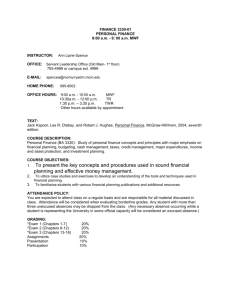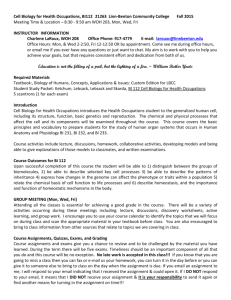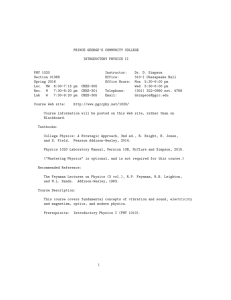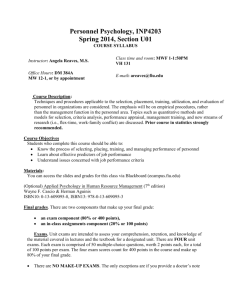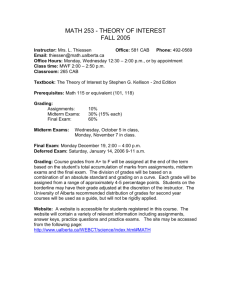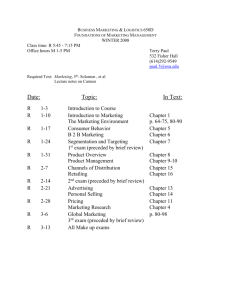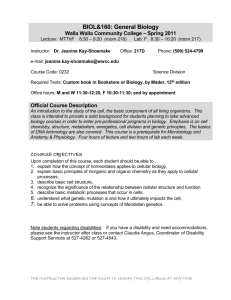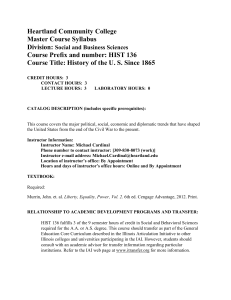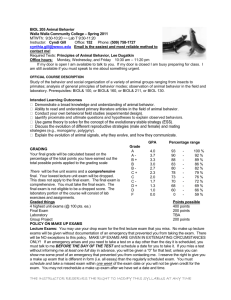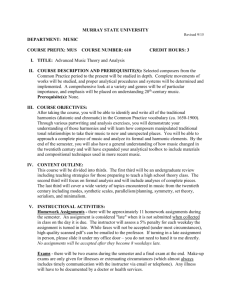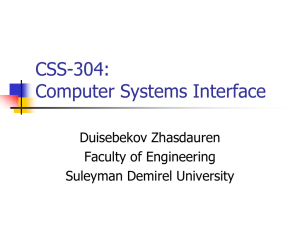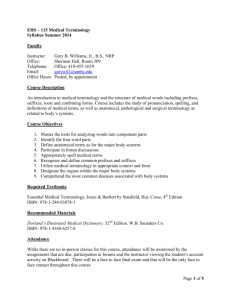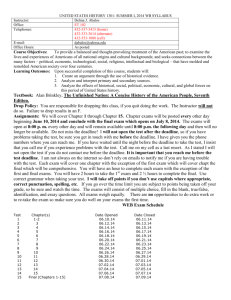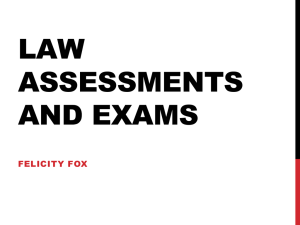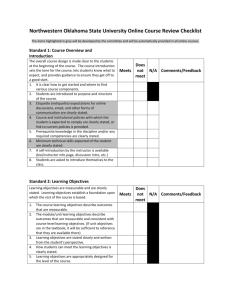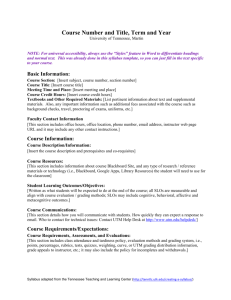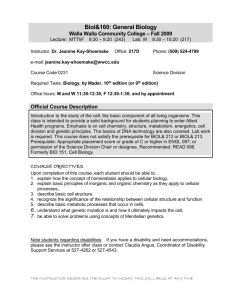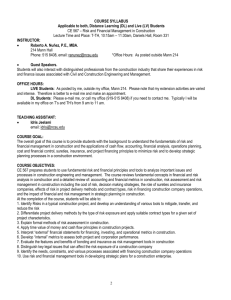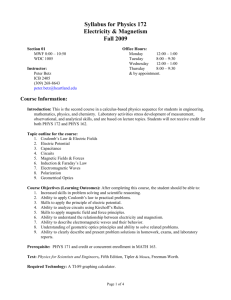SOC 4312.Population and Environment
advertisement
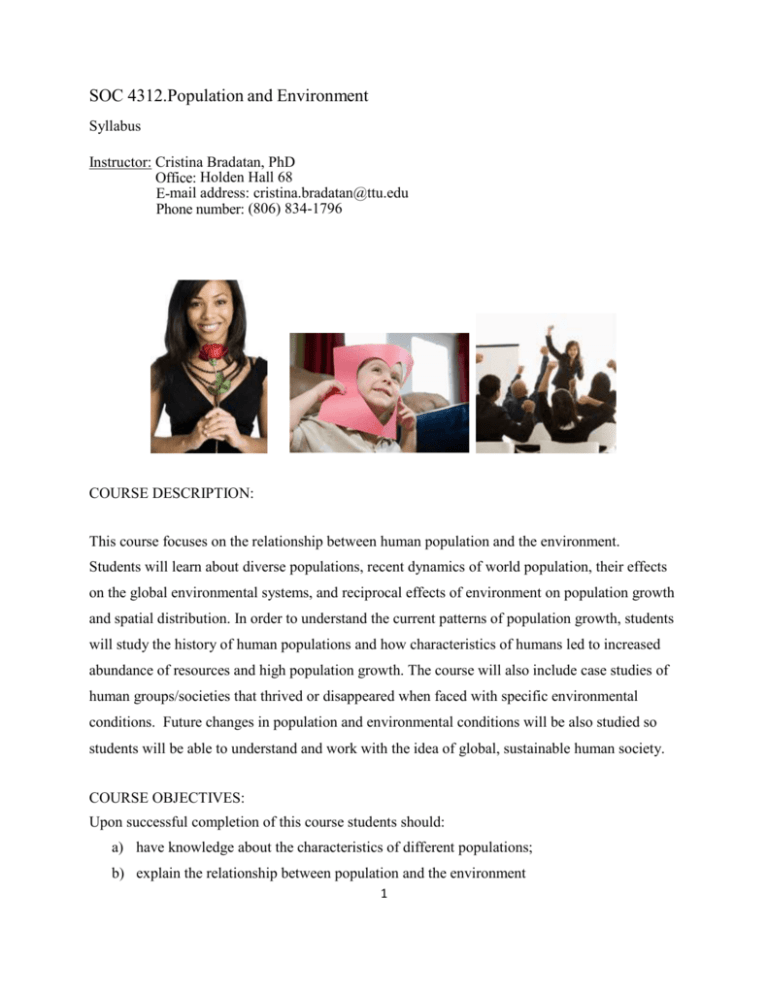
SOC 4312.Population and Environment Syllabus Instructor: Cristina Bradatan, PhD Office: Holden Hall 68 E-mail address: cristina.bradatan@ttu.edu Phone number: (806) 834-1796 COURSE DESCRIPTION: This course focuses on the relationship between human population and the environment. Students will learn about diverse populations, recent dynamics of world population, their effects on the global environmental systems, and reciprocal effects of environment on population growth and spatial distribution. In order to understand the current patterns of population growth, students will study the history of human populations and how characteristics of humans led to increased abundance of resources and high population growth. The course will also include case studies of human groups/societies that thrived or disappeared when faced with specific environmental conditions. Future changes in population and environmental conditions will be also studied so students will be able to understand and work with the idea of global, sustainable human society. COURSE OBJECTIVES: Upon successful completion of this course students should: a) have knowledge about the characteristics of different populations; b) explain the relationship between population and the environment 1 c) be able to understand and use basic population studies concepts d) understand population problems and their implications for public policies; e) have knowledge of national and international population policies METHODS OF ASSESSMENT OF LEARNING OUTCOMES Learning Outcomes: Students should be able to demonstrate an ability to critically assessof claims about: Characteristics different human populations Assessed by: Student assignment using UN databases on population characteristics in different countries Responses to exam questions testing their knowledge on the relationship between environment and population characteristics Student term paper and responses to exam questions regarding their knowledge of how population policies deal with various demographic phenomena Responses to exam questions regarding their knowledge of how economic and social variables interact with demographic phenomena The relationship between population and the environment Population problems and their implications for public policies. Relationships between population characteristics and economic and social development of a country The assessment of these learning outcomes will be done using: Graded papers and class presentations In class exams. All exams will be equally weighted Home assignments Class participation One-to-one tutorials Informal feedback via emails, discussions Required Texts: 1. Population: An Introduction to Concepts and Issues (10th edition) Author: John R. Weeks Publisher: Wadsworth Publishing Company, New York ISBN: 0-534-52976-3 2. The Dominant Animal: Human Evolution and the Environment Authors: Ehrlich, Paul R. and Anne H. Ehrlich Publisher:Washington: Island Press. ISBN: 2 978-1-59726-097-8 COURSE ORGANIZATION Throughout the semester, the students will take three exams and will do in class and take home assignments. Assignments: All students are required to do the assignments throughout the semester. Generally, the assignments will consist in either taking a short quiz or doing an exercise at home or in class. Detailed information of the assignments will be given out in the class. Class participation: It is important that you attend class regularly and you are active in class discussions. Attendance will be taken every day and will be worth a total of 10 points towards the final grade. It is expected that students read all assigned materials before class, and participate in class discussions. Exams: Exams will include both multiple choice and short essay questions. All exams will be weighted equally. Distribution of grades Exams 80% Assignments 15% Class Participation 5% Final grade = 0.8*Exams+0.15* Assignments+0.05*Attendance Grading Scale 98 and over A+ 93-98 A 90-92 A- 87-89 B+ 83-86 B 3 80-82 B- 75-79 C+ 70-74 C 65-69 C- 60-64 D 0-59 F Texas Tech University interpretation of the grades: A = Excellent; B = Good; C = Average; D = Inferior (passing, but not necessarily satisfying degree requirements); F = Failure. The + and - will be entered on the transcript but will not be used in the calculation of the grade point average. UNIVERSITY POLICIES AND REGULATIONS: The instructor of this course respects and upholds University policies and regulations pertaining to the observation of religious holidays; assistance available to the physically handicapped, visually and/or hearing impaired student; plagiarism; sexual harassment; and racial or ethnic discrimination. All students are advised to become familiar with the respective University regulations and are encouraged to bring any questions or concerns to the attention of the instructor. ABSENCES FOR RELIGIOUS HOLIDAYS: A student who is absent from classes for the observation of a religious holy day shall be allowed to take an examination or complete an assignment scheduled for that day within a reasonable time after the absence if, not later than the fifteenth day after the first day of the semester, the student had notified the instructor of each scheduled class that the student would be absent for a religious holy day. STUDENTS WITH DISABILITIES: Any student who, because of a disability, may require special arrangements in order to meet the course requirements should contact the instructor as soon as possible to make any necessary arrangements. Students should present appropriate verification from Student Disability 4 Services during the instructor’s office hours. Please note instructors are not allowed to provide classroom accommodations to a student until appropriate verification from Student Disability Services has been provided. For additional information, you may contact the Student Disability Services office at 335 West Hall or 806-742-2405. ACADEMIC INTEGRITY: Academic integrity is the pursuit of scholarly activity free from fraud and. Academic dishonesty includes, but is not limited to, cheating, plagiarizing, fabricating information or citations, facilitating acts of academic dishonesty by others, unauthorized possession of examinations, submitting work of another person or work previously used without informing the instructor, or tampering with the academic work of other students. Plagiarism, or academic theft, is passing off someone else’s work as your own. Please note: plagiarism simply means using someone else’s ideas without acknowledging it (no matter if you use that person’s actual words or not). Regardless of your background, you are responsible for not plagiarizing. OBSERVATIONS Before asking something related to the class, please read the syllabus. I am not going to reply to e-mails asking questions I already answered in the syllabus. 5 TENTATIVE WEEKLY SCHEDULE WEEK 1. Introduction: population and environment WEEK 2. Global population trends WEEK 3. Population and environment theories WEEK 4. Review. Exam 1. WEEK 5. Causes and timing of death WEEK 6. Who needs immigrants? Migration history, causes and effects WEEK 7. How many children do you want? Geographic distribution of fertility WEEK 8. Population pyramid and projections WEEK 9. Review. Exam 2 WEEK 10. How environment affects human population growth and distribution WEEK 11. Effects of human population on environment WEEK 12. Population growth, environment and food WEEK 13. Failed population- environmental relations WEEK 14. Future society and environment WEEK 15. Exam 3. 6
